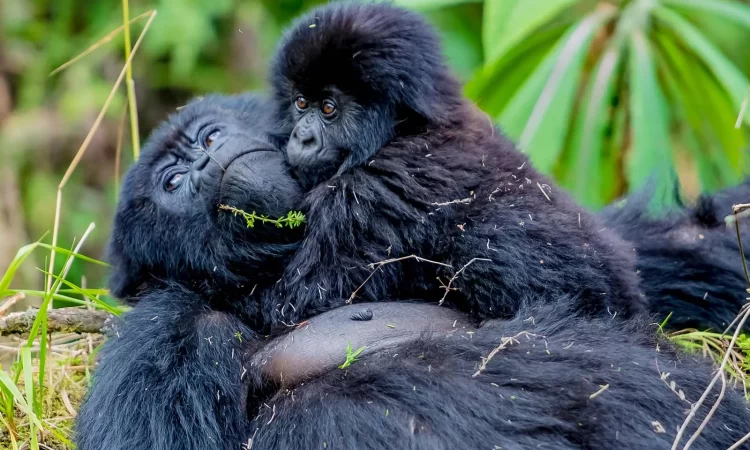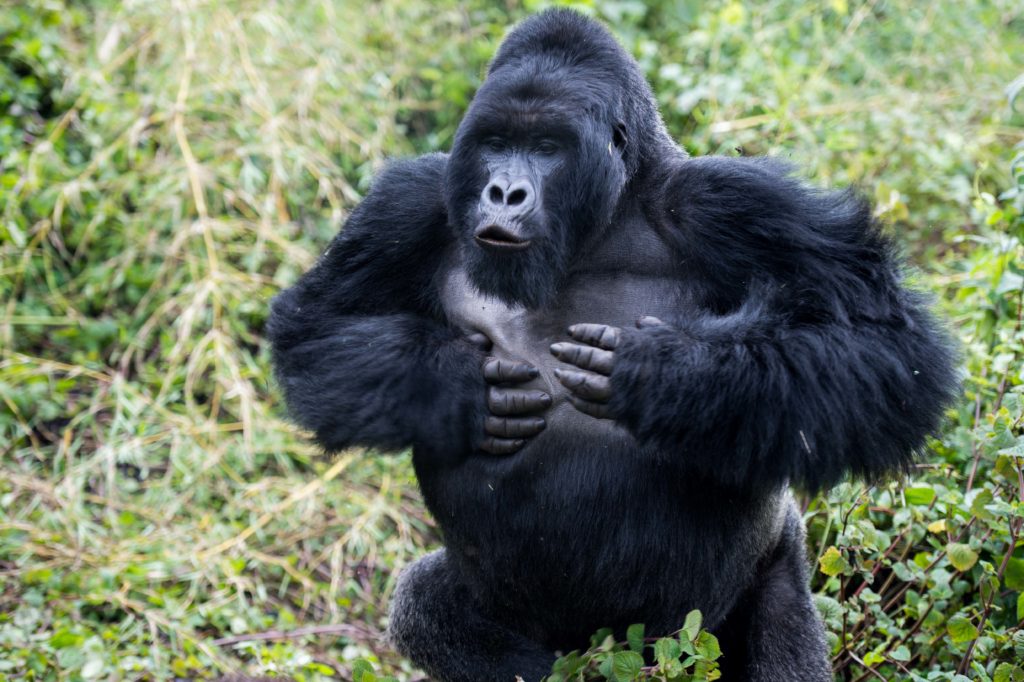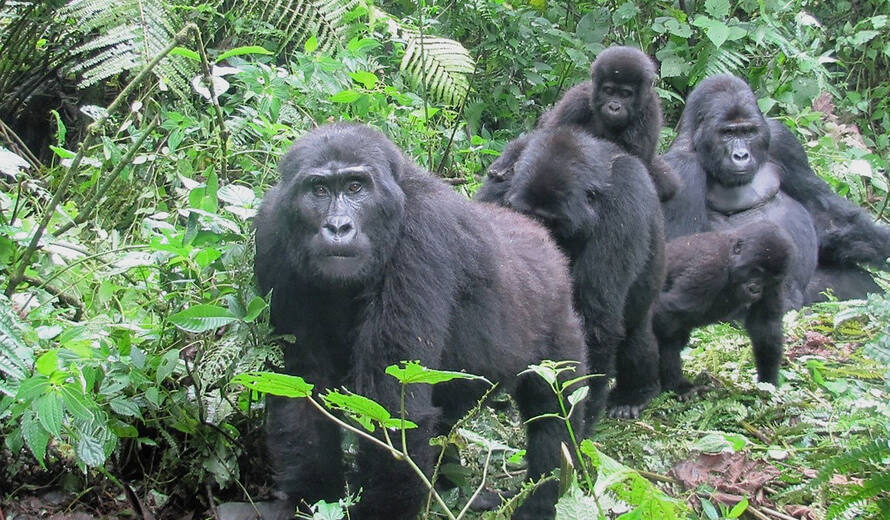Facts About Mountain Gorillas in Africa
Facts About Mountain Gorillas in Africa: Gorillas are the largest apes inhabiting forests, swamps, and lowland regions of East, Central, and Western Africa. Gorillas are classified into two species: Eastern gorillas and Western gorillas. The Western gorillas comprise the Western lowland gorillas and Cross River gorillas, whilst the Eastern gorillas consist of the Mountain gorillas and Eastern lowland gorillas. The eastern gorillas are categorized into two subspecies: the mountain gorilla and the eastern lowland gorilla, which are exclusively located in the Virunga Mountains and Kahuzi Biega National Park, respectively. Western lowland gorillas are frequently observed in zoos and are relatively widespread in Equatorial Guinea, Gabon, Congo-Brazzaville, Angola, the Central African Republic, Cameroon, and the Democratic Republic of Congo.

Mountain gorillas inhabit only East and Central Africa, specifically in Uganda, Rwanda, and the Democratic Republic of Congo. Consequently, they can only be observed in the parks that span these three nations: Bwindi Impenetrable Forest and Mgahinga National Park in Uganda, Volcanoes National Park in Rwanda, and Virunga National Park in the Democratic Republic of Congo. While other gorilla subspecies exist in Central, East, and West Africa, mountain gorillas are the most captivating and intriguing due to their status as the most endangered gorilla species globally.
Mountain gorillas are concealed within the fog-laden highlands of Rwanda, Uganda, and the Democratic Republic of Congo. Due to the effective conservation methods in the three nations, the population of mountain gorillas is expanding annually; nonetheless, Bwindi Impenetrable National Park in Uganda harbors the largest number of gorillas compared to Rwanda and Congo. Rwanda, however, is a premier site for gorilla trekking in Africa. Mountain gorillas are the most endangered apes globally, imperiled by human activities and habitat destruction; hence, several facts exist regarding mountain gorillas in Africa. They are the sole primate species on Earth with a rising population, and Rwanda has developed a flourishing economy centered on gorilla interactions. The following are prevalent characteristics of mountain gorilla species.
What are Mountain Gorillas?
Mountain Gorillas in Africa are scientifically referred to as ‘Gorilla beringei beringei’ or ‘western gorillas.’ They are recognized as the largest species within the ape order globally. Mountain gorillas are one of the two subspecies of the eastern gorilla, scientifically referred to as ‘Gorilla beringei.’ The other subspecies of the eastern gorilla is the eastern lowland gorilla, which resides in the deep forests of central and western Africa. Mountain gorillas, akin to other primate species, are herbivorous creatures.
The physical characteristics of a Mountain gorilla:
Among the 13 facts regarding mountain gorillas in Africa, one should be aware of this particular detail. Mountain gorillas in Africa measure approximately 1-2 meters in height, equivalent to roughly 4-6 feet. They are hirsute primates, characterized by longer fur and somewhat shorter limbs than the eastern lowland gorillas. Mountain gorillas possess a robust chest and powerful arms, adorned with dense black fur.

The social behavior of mountain gorillas in Africa:
Mountain gorillas are inherently sociable mammals. They inhabit groups including approximately 11 to 30 individuals, overseen by a dominant silverback. Nonetheless, small gorilla groups or families may consist of 5 to 10 people. A silverback gorilla is tasked with the responsibility of caring for all members of its group. The silverback safeguards its group against external and internal threats, including humans and male gorillas from rival factions. In instances of internal threats, the silverback gorilla safeguards all newborns and females within the group from being assaulted by unruly adult males in the same group. Typically, only the silverback gorilla mates with the females in his group; hence, he will engage in combat with other male gorillas to prevent them from mating with the female gorillas. It serves as a method for asserting his dominion and entitlements over the female gorillas within his group. Intra-group flights of mountain gorillas occur in pursuit of dominance. A silverback will engage in combat with another adult male gorilla, resulting in the victor assuming the role of the dominant male and leader of the group. Mountain gorillas in Africa are typically tranquil and docile creatures. They do not remain in the same location for two successive nights, primarily because to their constant pursuit of sustenance. Tourists observing mountain gorillas in Africa will consistently witness these gorillas engaging in mutual grooming. Grooming among gorillas is significant and serves as a means of social connection.
The reproductive cycle of mountain gorillas:
Female mountain gorillas possess an average gestation duration of 257 days, almost equivalent to 9 months. Female gorillas attain sexual maturity at 7 or 8 years of age and commence reproduction at 10 years or older. Upon reaching reproductive maturity, a female gorilla may deliver one or two offspring, although the occurrence of twin births is exceedingly uncommon. There are several gorilla groups in Rwanda, Uganda, and Congo that include twin newborn gorillas. Typically, the majority of twin baby gorillas perish at birth or within a few weeks thereafter. Upon the death of a baby gorilla, the mother typically continues to hold the deceased offspring for a period before ultimately relinquishing the lifeless form. A female mountain gorilla typically births one offspring every 4-6 years, producing just three or four offspring throughout her lifespan. Male gorillas attain sexual maturity at a later age than females. The sluggish reproductive rate of mountain gorillas significantly impacts their population size. This complicates the rapid population recovery of many animals after their significant decrease millennia ago. Mountain gorillas were initially classified as a critically endangered species in 1996, according to the IUCN Red List of Threatened Species. In November 2018, it was reported that these gorilla species are no longer classified as severely endangered. The significant growth in the population of mountain gorillas is attributable to the conservation initiatives of numerous wildlife organizations.
In which regions of Africa do mountain gorillas reside?
Mountain gorillas, specifically western gorillas, inhabit only the dense tropical rainforests of Uganda, Rwanda, and the Democratic Republic of Congo. Consequently, any tourist desiring to observe mountain gorillas in their natural habitat must purchase a gorilla trekking excursion in one of the aforementioned countries. In Uganda, travelers can observe mountain gorillas in Bwindi Impenetrable National Park and Mgahinga Gorilla National Park; in Rwanda, visitors can encounter mountain gorillas in Volcanoes National Park. Mountain gorillas inhabit the tropical rainforests of Virunga National Park in the Democratic Republic of the Congo.
What is the weight of mountain gorillas in Africa?
Mountain gorillas are the largest primates globally, with males weighing from 120 to 220 kg, equivalent to around 260 to 485 pounds. Females can weigh between 68 and 113 kg, equivalent to 150 to 250 pounds. An adult male mountain gorilla can exceed 136 kg in weight, while a silverback typically weighs between 195 and 220 kg. An adult female mountain gorilla can weigh between 86 and 113 kilograms. A newborn gorilla typically weighs between 3 to 5 pounds and is commonly designated as a baby. Mountain gorillas inhabit groups or families, governed by an adult, dominant male known as a Silverback. Silverback gorillas typically safeguard the group members, particularly the females and infants.
What is the lifespan of mountain gorillas in Africa?
This comprises thirteen intriguing facts on mountain gorillas in Africa. In the wild, mountain gorillas typically live for 40 to 50 years; but, in captivity, such as at a zoo, their longevity may extend to 60 years. The oldest reported western gorilla was a female that lived to be 60 years old and passed away in 2017 at the Columbus Zoo.
What is the diet of mountain gorillas in Africa?
Mountain gorillas are predominantly herbivorous creatures. Their diet primarily consists of plant stems, leaves, fruits, flowers, and bamboo shoots. Mountain gorillas may consume approximately 50 pounds of foliage day, equating to half of their body weight. Their diet includes insects, snails, and ants, rendering them somewhat omnivorous mammals.
What is the degree of similarity between a mountain gorilla and a human being?
Scientific research has demonstrated that mountain gorillas share 98% of their DNA with us genetically. Consequently, it is unsurprising that mountain gorillas exhibit human-like traits and feelings, including guilt, happiness, and melancholy. Mountain gorillas can contract diseases analogous to those affecting humans, including influenza, cough, Ebola, and arthritis, which impacts their joints, fingers, hands, and feet. Similar to humans, mountain gorillas experience tooth loss in old age. This disrupts their typical feeding rhythm, making it challenging for the gorilla to consume food at the same pace as its peers. Mountain gorillas exhibit mourning behaviors for deceased members, often congregating around the corpse of a fallen gorilla.
What methods do mountain gorillas employ for communication among themselves?
Mountain gorillas in Africa utilize a variety of vocalizations and gestures for communication, including hooting, yelling, barking, laughing, snarling, charging, belching, signing, yawning, and chest-beating, among others. Every unique vocalization produced by a gorilla conveys a specific message; for example, a gorilla’s charge serves as a warning of potential danger. Dian Fossey, the American primatologist and conservationist, found 17 distinct vocalizations produced by mountain gorillas.
What are the primary challenges to mountain gorilla populations in Africa?
A variety of hazards impact the population of mountain gorillas in Africa, including diseases such as Ebola, influenza, and tuberculosis, among others. Mountain gorilla populations are endangered by poachers who pursue these gorillas for their bushmeat to satisfy the substantial demand in the black market. A significant hazard to mountain gorilla populations in Africa is habitat loss. The ongoing deforestation of rainforests for lumber, mineral extraction, gas, and agricultural expansion has adversely affected the population of mountain gorillas in Africa. Statistics indicate that merely 17% of the entire mountain gorilla population resides in safeguarded regions such as national parks and forest reserves in Africa. Consequently, mountain gorilla populations residing beyond these protected zones face significant threats due to ongoing habitat encroachment.
What is the current population of mountain gorillas in Africa?
The estimated number of mountain gorillas in Africa exceeds 1,004 individuals, as reported by the African Wildlife Foundation. The Virunga Massif is home to this population of mountain gorillas, with Uganda reportedly harboring fifty percent of Africa’s total mountain gorilla population.

What actions to take when in the presence of mountain gorillas?
This is one of the 13 essential facts regarding mountain gorillas. Given that mountain gorillas share 98% of their DNA with humans, they similarly experience emotions such as happiness, frustration, fear, and wrath. Consequently, people hiking mountain gorillas in Africa should adhere to these set of principles when in the presence of these primates;
